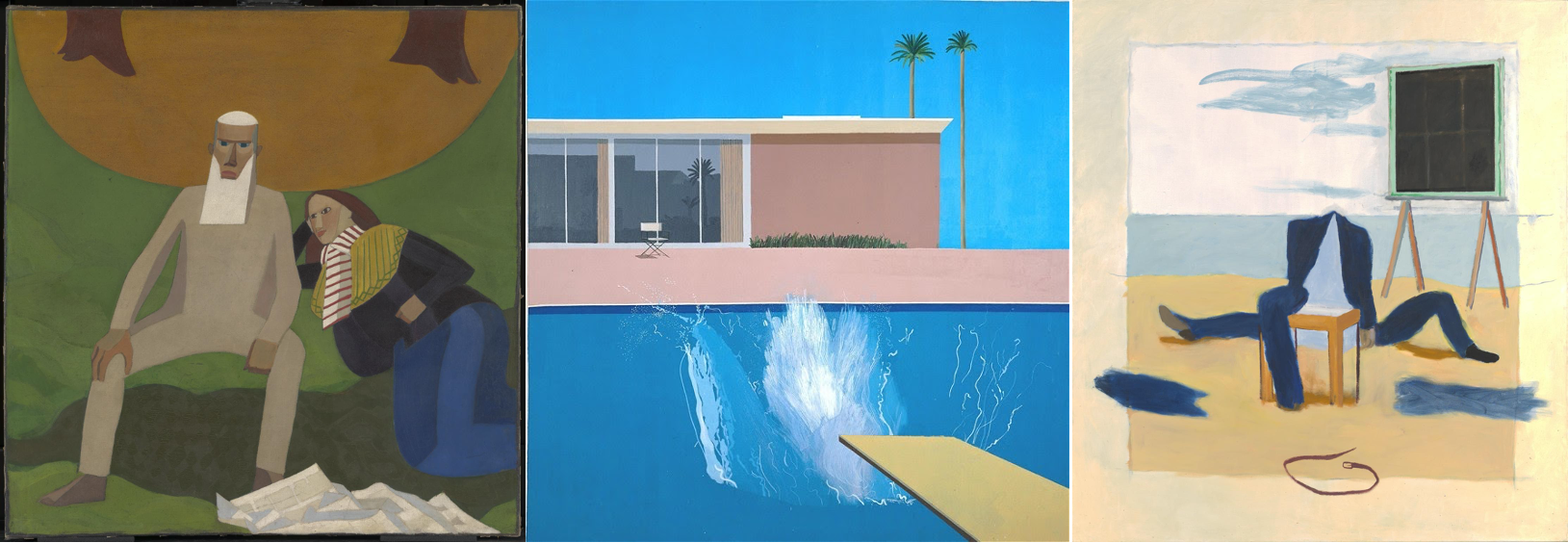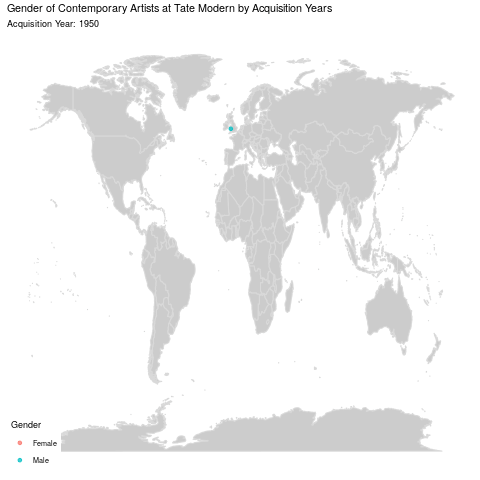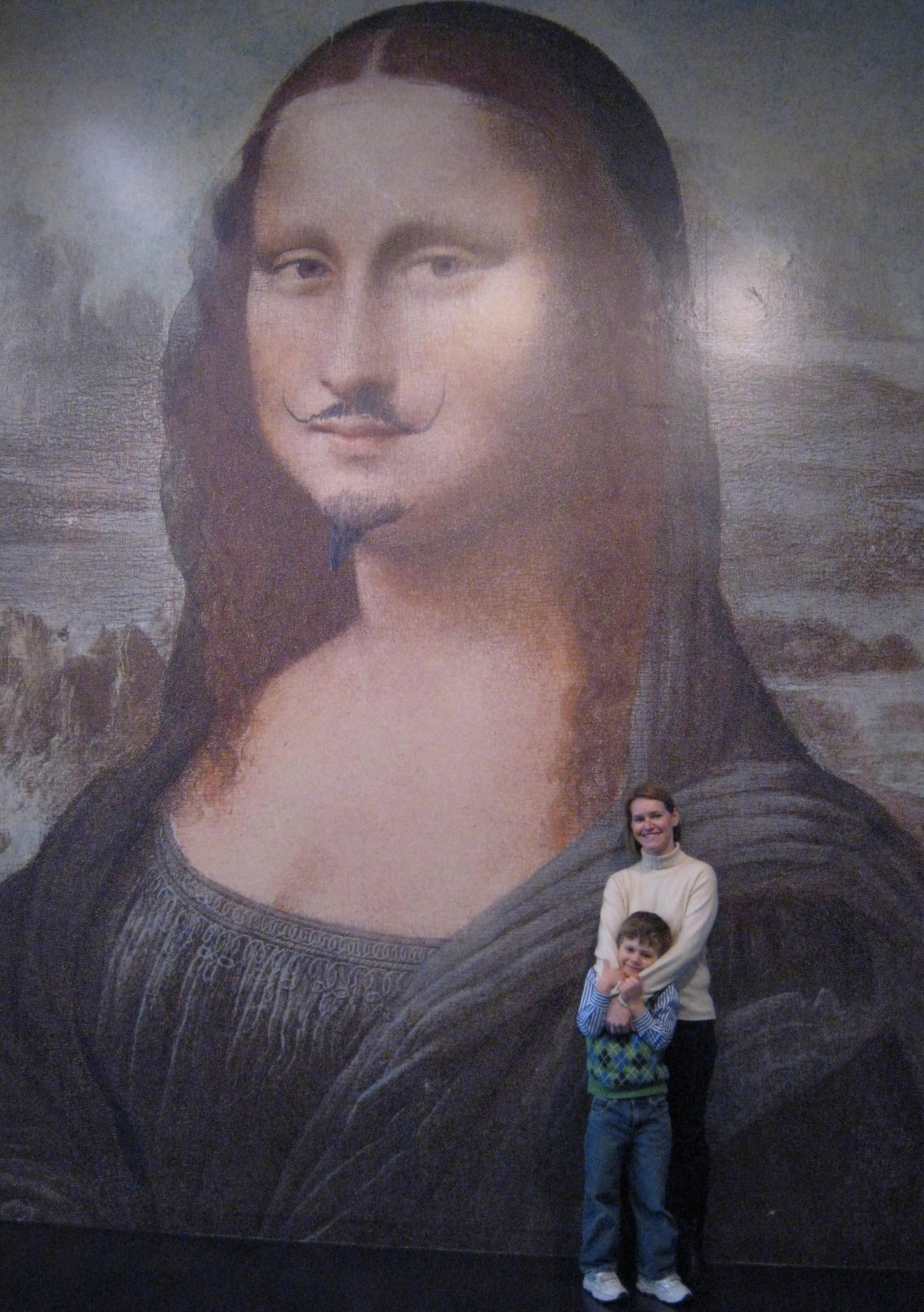Introduction
As an institution that houses, in a network of four art galleries, the United Kingdom’s national collection of British art, and international modern and contemporary art, Tate is one of the most renowned and glamorous museums for art-lovers in the world. In this post, we are going to explore the data set of Tate collections from 1950 to 2013, which includes details about the artworks and also information of correspinding artists. The data set is gained from tidytuesday and it was last updated in October 2014.
Here is some data wrangling that we did:
Combined
artwork.csvandartists.csv.Used
ggmapand API to geocode birth cities of artists.Filtered the data so it only includes contemporary artworks (1950 - 2013).
Dropped
NAsfor used variable.
Where the chosen pictures come from
Show code
tate_table <- tate %>%
select(title, ArtistFirstName, ArtistLastName,
gender, medium_drawn_on, acquisitionYear,
BirthCountry, BirthCity, lon, lat) %>%
filter(title %in% c("A Bigger Splash",
"Bank Holiday on Hampstead Heath",
"Rien")) %>%
mutate(BirthCountry = case_when(BirthCountry == "Misr" ~ "Egypt",
TRUE ~ as.character(BirthCountry))) %>%
rename('Title' = title,
'Acquisition Year' = acquisitionYear,
'Gender' = gender,
'Medium Drawn On' = medium_drawn_on,
'Longitude' = lon,
'Latitude' = lat,
'Artist First Name' = ArtistFirstName,
'Artist Last Name' = ArtistLastName,
'Birth Country' = BirthCountry,
'Birth City' = BirthCity
)
gt(tate_table) %>%
tab_spanner(label = "Birth Place",
columns = vars("Birth Country", "Birth City")) %>%
tab_spanner(label = "Geo-Location",
columns = vars("Longitude", "Latitude")) %>%
tab_header("When did Tate Museum Acquire following Artworks") %>%
tab_source_note("Source : https://github.com/rfordatascience/tidytuesday/blob/master/data/2021/2021-01-12/readme.md")
| When did Tate Museum Acquire following Artworks | |||||||||
|---|---|---|---|---|---|---|---|---|---|
| Title | Artist First Name | Artist Last Name | Gender | Medium Drawn On | Acquisition Year | Birth Place | Geo-Location | ||
| Birth Country | Birth City | Longitude | Latitude | ||||||
| Rien | Willing | Victor | Male | canvas | 1980 | Egypt | Al-Iskandariyah | 44.3473041 | 32.88959 |
| A Bigger Splash | Hockney | David | Male | canvas | 1981 | United Kingdom | Bedford | -97.1430671 | 32.84402 |
| Bank Holiday on Hampstead Heath | Carline | Sydney | Male | canvas | 1975 | United Kingdom | London | -0.1277583 | 51.50735 |
| Source : https://github.com/rfordatascience/tidytuesday/blob/master/data/2021/2021-01-12/readme.md | |||||||||
Show code
#title and source

Where are they from?
Show code
tate %>%
filter(year>1950) %>%
leaflet() %>%
addTiles() %>%
addMarkers(lng = ~lon, lat = ~lat,
clusterOptions = markerClusterOptions())
Where art in the Tate Collection comes from (By artist birth place)
While pieces by British artists represent the majority of pieces, there is still a large amount of pieces by international artists. What stands out are three trends to these artists
An art historian who was familiar with the topic stated that the curators and board likely included artists who were trained in the UK or had considerable contact with British art commissioners
Most countries represented in the gallery from outside of Europe are former British colonies. As an example of this phenomena, Singapore has 58 pieces while it’s neighbor to the north, Malaysia, only has one piece in the Tate Collection.
This is in line with the Tate Museum mission statement:
Our mission is to increase the public’s enjoyment and understanding of British art from the sixteenth century to the present day and of international modern and contemporary art.
- Wealthier countries have more pieces represented in the gallery
What and When Tate Museum Acquired their Artwork
Show code
ggplot(tate, aes(x = acquisitionYear, fill = medium_drawn_on))+
geom_bar()+
xlim(1950,2013)+
labs(x= "Year Acquired by Tate", y= "Number of Artwork", fill = "Base Material")+
theme_bw()

Tate Museum was an exclusive British art institution that selected artworks mainly from the British Royal Academy. However, since 1950s (after the end of World War 2) the museum undergone a significant change to accept wider range of artworks from different artists. According to Mrs. Tamatha Jordan, British Art historian who worked at the British Museum, the drastic increase of intake in painting in late 1970 was due to baby born after the World War 2 took more risk and explored their talent which resulted in British artwork. Moreover, it is likely that major board member of the Tate Museum perished during the war, which lead to new and daring board members. Late 1990s explosion of artwork is due to Tate Museum opening up a new branch of Tate Museum called Tate Modern. They became much more daring and unique. Moreover, all British museums that take government funding require easy accessibility to the public, and follow the public sentiment on art.
Gender Equality in Tate Collections
Show code
world <- ggplot() +
borders("world", colour = "gray85", fill = "gray80") +
theme_map()
animated_map <- world +
geom_point(aes(x = lon, y = lat, color = gender),
data = tate_gender,
alpha = .75) +
labs(color = 'Gender', title = 'Gender of Contemporary Artists at Tate Modern by Acquisition Years',
subtitle = 'Acquisition Year: {closest_state}') +
transition_states(acquisitionYear, transition_length = 1.5, state_length = 2.5) +
ease_aes("linear")
animate(animated_map, nframes = 600, fps = 60, end_pause = 20)

Show code
prop <- tate_gender %>%
count(acquisitionYear, gender) %>%
group_by(acquisitionYear) %>%
mutate(prop = n/sum(n)) %>%
ungroup()
ggplot(prop, aes(x = acquisitionYear, y = prop, fill = gender)) +
geom_area() +
labs(x = "Acquisition Year",
y = "Proportion",
color = "Gender",
title = "Proportion of Tate Artworks by Gender") +
scale_y_continuous(labels = scales::percent)

Analysis of the Gender Equality in Tate Collections
What is the proportion of artworks by female artists among Tate acquisitions?
Based on the cumulative data from 1950 to 2013, the proportion of contemporary artworks by female artists at Tate museum is only 12.9%, whereas 87.1% by male artists. It can be reasonably assumed that Tate museum perceives that great works of art are mostly created by men. The dominance of male artists in the collections shows the dire situation for equality in the British visual arts.
The animated map presents the change in the distribution of Tate artists by gender over time, from which we can see a growth in diversity of Tate acquisitions with respect to both artists’ gender and region. With an increasing awareness of existing gender inequality issues in the art field, the equality in Tate collections are improving. As the trend shown by the line plot, in 2002, the proportion of artworks by females went up to 43%. Such slight improvement, however, is far from enough since the proportions after 2002 manifest the fact that Tate museum’s annual acquisitions continue to have a stark gender disparity.
This data set only includes data until 2013. A more recent article illustrates that such gender imbalance is still severe and more efforts are needed to equalize collections.
Errors and Biases
- The data set does not discern whether or not a piece is on display, and which Tate museum it currently resides in.
- We filtered approximately 58,000 pieces of art from the data set
- The Tate museum is an extremely large and well funded set of museums and conclusions about the Tate are not directly applicable to other museums
- Does not include on display items or temporary exhibits
- Spikes in collection of new pieces of art are strongly correlated to the opening of a new Tate museum.
- Data only goes to 2014
Conclusion
The Tate museum stands as a bastion of the great British Museums. The Tate Museums combined attract nearly 8 million visitors a year and the Tate Modern is in the top 10 most visited museums. What is more impressive is that it has no admission fee to see the galleries that are on display.
While it’s innovative presentation of artwork has marveled the eyes of the visitors it also tells a tale of how the art world has shifted over the past 60 years, and how it is still stagnant. Although the Tate’s mission statement does center on highlighting “British art” it disproportionately disregards female artists and artists from non-traditional backgrounds.
A Final Note

Taylor grew up in the UK and took some of her first steps in front of the Tate Modern Museum.
Also consulted in this project was her mother who is an art historian that studied in the UK at The British Museum.
It should also be noted that Taylors favorite exhibition as a child was the temporary exhibition Shibboleth also known as “That crack that a bunch of small children fell into at The Tate Modern Museum.”